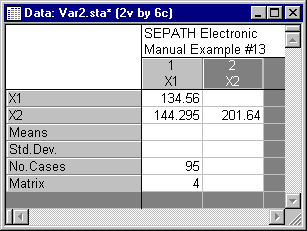Example 13: Comparing Dependent Variances
SEPATH can be used to perform pattern hypotheses on a covariance matrix. As a simple example, consider some data gathered by William E. Coffman, and reported by Lord (1963). These data represent performance on the Stanford Achievement Test for 95 students measured in the seventh and eighth grades. The covariance matrix for the data is in the Var2.sta data file.

Suppose you want to test the hypothesis that the population variance had not changed from seventh to eighth grade. The PATH1 specification for such a hypothesis (contained in the file Var2.cmd) is as follows:
[X1]-1-[X1]
[X2]-1-[X2]
[X1]-2-[X2]
The Chi-square statistic indicates that the hypothesis of equal variances can be rejected, as the probability level is a very small value, i.e., around .0001.
